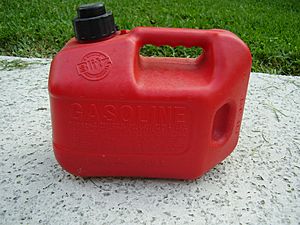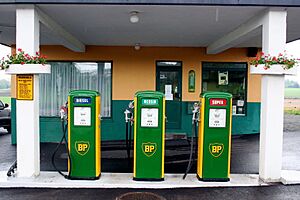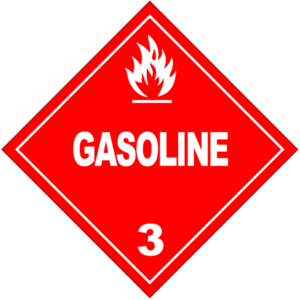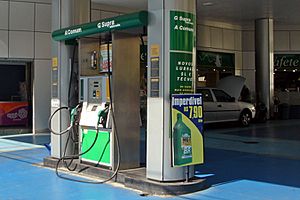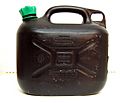Gasoline facts for kids
- This article is about the liquid fuel and industrial solvent. For the methane gas fuel, see Natural gas
Gasoline or petrol is a clear liquid that is mostly used as a fuel for internal combustion engines. You find these engines in cars and many other machines. Gasoline is made from petroleum, which is a fossil fuel. To get gasoline, petroleum is heated to a very high temperature. This process separates it into different parts, and gasoline is one of them. Gasoline is mainly made of a substance called octane.
You can buy gasoline at gas stations. Different brands of gasoline have special ingredients called gasoline additives. These additives help the fuel burn correctly in engines. Gasoline is also given an octane rating. This rating tells you how well the gasoline will burn without causing problems in the engine. Most cars use "regular" gasoline, which has an octane rating of 87. Some special engines need "premium" gasoline, which has a higher rating like 93. Gas stations usually offer different types of gasoline with different octane ratings and prices.
Contents
What is Gasoline Used For?
Gasoline is most often used in vehicles like cars and vans. But it powers many other things we use every day! This includes lawnmowers, leaf blowers, and small boat motors. Larger vehicles, such as big trucks or ships, often use diesel fuel instead of gasoline.
Why is Gasoline Dangerous?
Gasoline can be very dangerous. It can explode easily if an electric spark or flame touches it. It is also harmful if someone drinks it or if it gets on their skin.
Using gasoline also affects the environment and our health. When gasoline burns, it creates harmful gases like carbon monoxide. This gas is very poisonous. If a gasoline engine runs indoors or in a closed space, carbon monoxide can build up quickly and cause death in minutes. Sadly, many people die each year from using gasoline-powered generators indoors or leaving vehicles running inside a garage.
Some newer vehicles, like electric cars, do not use gasoline. This means they do not create carbon monoxide. They are also better for the environment and safe to leave running in a garage.
How is Gasoline Used and Priced?
Many countries use a lot of gasoline. For example, the United States uses a large amount of the world's gasoline each day.
Gasoline Prices in Different Countries
Countries in Europe often add high taxes to gasoline. This makes the price of gasoline in Europe much higher than in the United States. For example, gasoline in Europe can cost more than twice as much as in the US.
In the United States, gasoline prices can change a lot. This is because the taxes on fuel are lower compared to Europe. From 1998 to 2004, the price was usually between $1 and $2 per U.S. gallon. After 2004, prices went up, reaching about $4.11 per gallon in 2008. Prices then dropped but have gone up again at times.
Gasoline prices in the US include taxes from federal, state, and local governments. These taxes help pay for maintaining roads.
Different Types of Gasoline
About 9% of all gasoline sold in the US is "premium" grade. Some car makers suggest using premium gasoline. However, many modern cars have special computers that can adjust the engine to run well on regular gasoline, even if premium is recommended. This means most cars can use regular gasoline, though performance might be slightly different. Experts say you only need premium gas if your car's manufacturer says it is "required."
To use less imported oil, the US also uses mixtures of gasoline and ethanol. These include Gasohol (10% ethanol) and E85 (85% ethanol).
Brazil's Ethanol Fuel
Brazil has the biggest industry for making fuel from ethanol. Gasoline sold in Brazil contains at least 25% ethanol. Also, many new cars in Brazil can run on pure ethanol fuel. This ethanol is made from sugar cane and is known for being good for the environment because it helps remove carbon from the air.
Images for kids
-
When gasoline burns without control, it makes a lot of soot and carbon monoxide.
See also
 In Spanish: Gasolina para niños
In Spanish: Gasolina para niños


